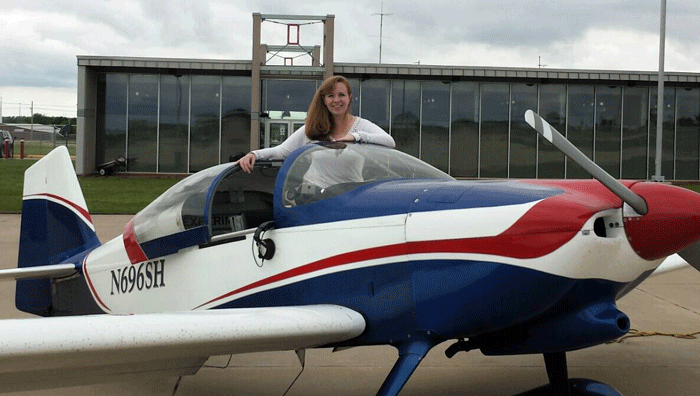
ENID, OK – Lt. Col. Deirdre Gurry this week completed her personal mission to fly into all 108 public-use airports within the Oklahoma Airport System (OAS). Gurry is a military and general aviation pilot and hangars her plane at Enid Woodring Regional Airport (KWDG).
In pursuit of general aviation, Gurry purchased an RV6 aircraft a little more than a year ago. Itching for an aviation adventure, it was mid-winter when she began looking for a goal to keep her busy. She said the idea came to her when she received the 2018 Oklahoma Aeronautics Commission (OAC) official aeronautical chart during the Oklahoma Women in Aviation & Aerospace Day event held in Tulsa.
Gurry’s journey launched this past December and was fulfilled April 24th at Duncan’s Halliburton Field (KDUC). Over a four month period, she took nine day-trips with the Oklahoma Panhandle being her longest.
“I enjoyed finding buildings with paintings on the roofs. It’s fun to think about the people who leave the art just for us pilots to find! I’ve seen an eight-ball, a smiley face, and even a rooster!” said Gurry. “One thing that was a small, but fun, challenge was transiting between the airports that were very close. I would only do one “touch and go” or “low approach” to wet grass fields, and then move on to the next. With some airports very close, switching frequencies, finding the airport, and scanning for traffic kept me on my toes.”
Oklahoma has 4 commercial airports and 104 public general aviation airports and Gurry landed at every one of them. The OAC is a non-appropriated agency funded directly by users of the state airport system through aircraft excise and fuel taxes, and aircraft registration fees. These taxes and fees generate $5 million on average annually funding the OAS.
“Lt. Col. Gurry probably has some great insight as to how the Aeronautics Commission is doing in our mission to maintain and improve the state’s airports,” said Grayson Ardies, deputy director of the Commission.
“Pilots using the state’s runways can tell you that our pavement has dramatically improved over the past two decades, and we are proud of our 108 airports. A commitment by state, local, and federal officials has resulted in what is now a well-maintained comprehensive airport system,” Ardies continued. “OAC’s recently proposed Airport Construction Program (ACP) which invests $130M of federal/state/local funding in 66 projects will go a long way in helping ensure the state’s runways, taxiways, and other infrastructure items are the best they can be for the users of the system.”
Nearly twenty years ago, federal funding for Oklahoma general aviation airports was significantly lower. The Legislature providing dedicated funding sources enabled agency staff to develop an ACP proving to the FAA (Federal Aviation Administration) that the state was serious about improving their air transportation system, and now, the FAA uses Oklahoma as a model when talking to other states.
“My home airport is Woodring Regional in Enid. The runway is in great condition and very long. And the shorter runway is great for those strong-crosswind days.” said Gurry.
The 2,000 foot extension to the runway at Enid Woodring Regional Airport completed a few years ago would not have been possible without the largest State/OAC airport grant ever of $2.5 million. The extension was done so that T-38 trainer jets from nearby Vance Air Force Base could land and takeoff from the Enid regional airport rather than having to go to Wichita or Tulsa to train when the main runway at Vance is closed for maintenance. The record investment from OAC was necessary because the FAA could not invest what it usually would because the extension was driven mostly by military rather than civil aviation demand. This is just one example of several critical state investments in airports that the OAC has been able to do.
The core responsibility of OAC has been to ensure that the needs of communities and commerce across the state are met by a system of public airports, the Oklahoma Airport System (OAS). Since 2001, OAC has received $82 million from aviation-generated revenues and invested $68 million in airport infrastructure across the State—83% of the revenue that OAC received has been invested in airport infrastructure. That is a rate of return the users of the OAS, who pay the aircraft taxes and fees, can be very proud.